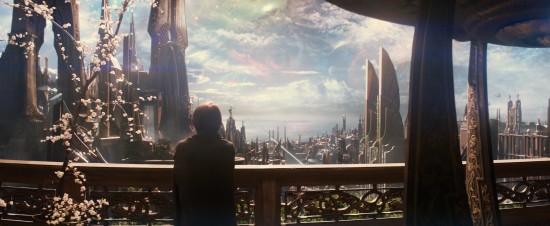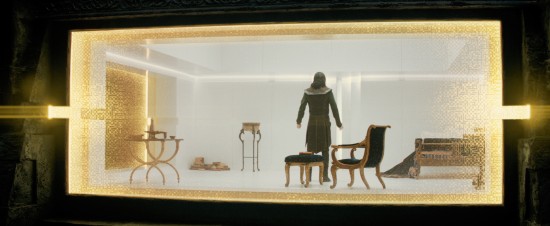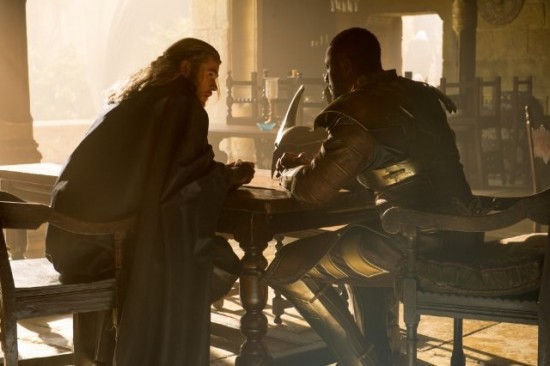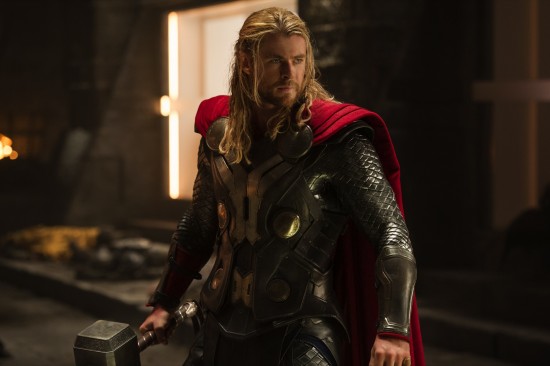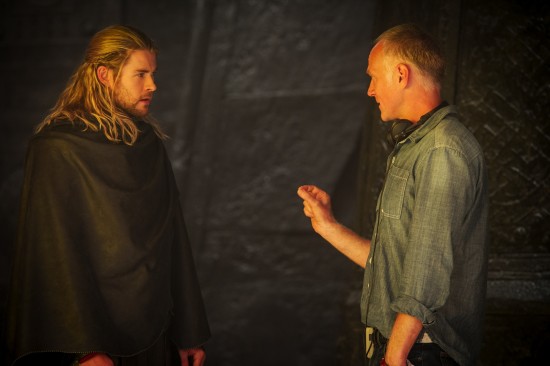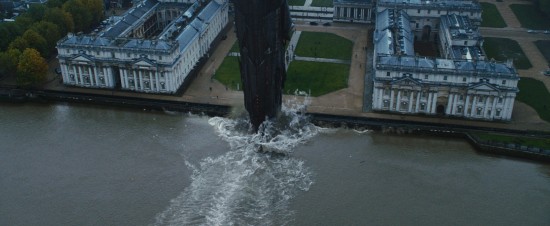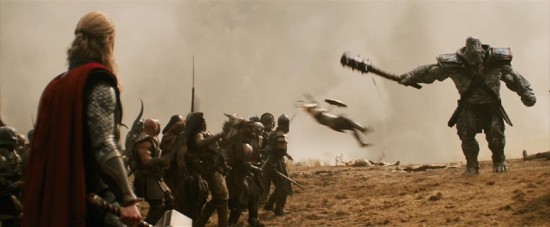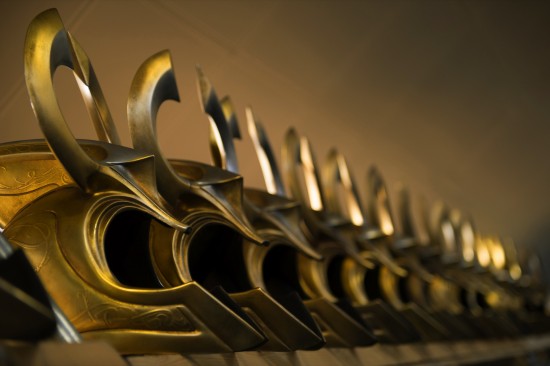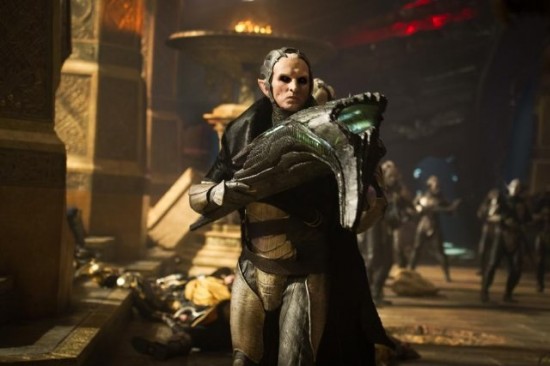50 Things We Learned On The Set Of 'Thor: The Dark World'
Last year, I traveled to London to visit the set of the Marvel sequel Thor 2: The Dark World. The photo above is me holding Mjölnir, Thor's iconic hammer – it's actually heavier than it looks — in the massive weapon room of the film's production offices. After the jump you can read about the many things that I learned while on set, and watch a video blog reaction I recorded after the visit. Later this week we'll be publishing some of the interviews we conducted on set with the talent and crew, so be on the look out for them as well.
Video blog with Frosty from Collider:
50 things I learned on the set of Thor: The Dark World:
The scope of this film is intended to feel massive. Thor 2 is set in both Asgard and Midgard (i.e. our Earth), but we do see more of Asgard and the nine realms than we did in Thor. The story will be half based on Earth and half set in Asgaurd and other worlds. While the story does involve Earth in a big way, SHIELD doesn't have much of a presence in this film.
Earth will feel the presence of "the singularity," a flex in the universe. Fault lines across the universe contract every few thousand years, and this is the first time it's felt on Earth. We saw concept art of kids running around an abandoned warehouse where they see a cement truck rotating in the air.
Asgard was is built by Thor's great grandfather, grandfather and father, and each location has many layers of history. A real effort was made to make the Asgard sets multilayered and highly textured, using as much practically-built sets and real locations as possible, mixed with digital set extensions which will be added by artists in post. The set design is grounded in a more organic design sense than that of the original film, kind of like how Game of Thrones is set in a reality-based world with fantasy overtones.
Jake Morrison, the visual effects supervisor, pushed to shoot base footage whenever possible — to shoot basic plates and aerial work used to insert visual effect augmentation, rather than create full shots in the computer.
Marvel traveled to Iceland early in the shoot, filming seven days in the freezing cold. The filming included volcanic lava-capped mountains. Svartalfheim looks very otherworldly and they shot on location in Iceland to archive some of the exteriors.
They also shot on location in London. Huge action scenes take place in and around London, featuring some of the big landmarks of the city. Stonehenge also plays into the storyline. Marvel shot on location at Stonehenge instead of recreating it on stage.
The advancements of Asgard are always present in every scene in that world, to keep the science fiction angle front and center so that it doesn't just become another Game of Thrones/Hobbit looking fantasy film.
We get to see the darker underbelly of Asgard, where the non-royal characters live. We visited second unit production where they were filming Loki in a prison cell in the palace dungeon. The room is made up of primarily charcoal-black bricks, with a 20-foot tall door at the front. There's a long dungeon hallway, like something out of Dungeons and Dragons, with completely white rooms on either side, reminiscent of 2001. Yellow lighting comes from the front of the rooms, giving the effect of a force field jail wall. The hallway has eight of these rooms. Asgardian patterns line the middle of the hallway. Loki's cell is furnished with books; gifts from Frigga to make him feel more at home. We watched a rehearsal of a handful of Asgardian guards running around the corner and down the hallway.
The biggest set of the film is the Medina set, which took 4 months to build. The outside freestanding set features a pub with a big fireplace in the corner. The pub feels like a place warriors have been going after battles for generations, telling tales of their valor. In the background is the Asgardian training grounds, where the warriors train for the battles happening all across the cosmos. Huge 30-foot wide columns stand 25 feet, which will be enlarged with set extensions, and there's blue screen in the background. A courtyard has brick structures with golden Asgardian designs built into them. Greenery wraps along the structures. A big golden arch rises 20 feet in the air before it stops, to be filled in later by CG set extension. Huge fire goblets are all around.
Production design referenced Jack Kirby's designs as Marvel impressed the importance of his work, but much of the architecture in the film is based on a mashup of real-world details.
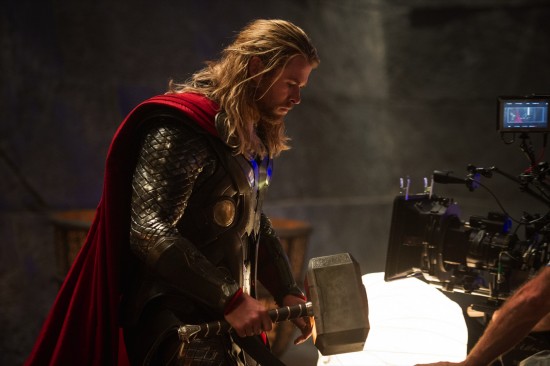 Connection To The Marvel Cinematic Universe:Thor: The Dark World will pick up one year after The Avengers and two years after the first Thor movie.
Connection To The Marvel Cinematic Universe:Thor: The Dark World will pick up one year after The Avengers and two years after the first Thor movie.
The film will link up with the second phase of the Marvel universe but is more of a separate story than most of the movies in the first phase.
Feige says that "the threads that will build to the greater threat will always be seeded" but the Avengers films will be an additional payoff, not what is driving these single films.
Tom Hiddleston and Chris Hemsworth first talked about the story for the sequel with producers while doing press for The Avengers. Tom thinks that some ideas he provided may have made it into the film.
We visited the set for Jane Foster's London apartment, which is supposed to be a studio apartment but is actually a huge space complete with a big patio. The many small details in her apartment were impressive. A newspaper clipping on her fridge reads "Citizen narrowly escapes death on the streets of New York," with a photo of Thor in the rumble of NYC. There's another clipping about an "asteroid on a crash course with earth" and saying "particle sheds light on dark matter." A paper on the coffee table: "Einstein-Rosen Bridge Theory: The New Reality." Jane has a ton of bookshelves filled with books on science. In the kitchen, I spotted a coffee cup with the lower case letter "j" on it. On a cork board is an article, "Blurry Photo Captures Epic Battle at Stark Towers". Who knows if any of these details will even be seen in the film.
Multiple actors refused to answer if the Tesseract was still a factor in this film, so it most likely is.
We will not see inside Odin's vault again in this sequel.
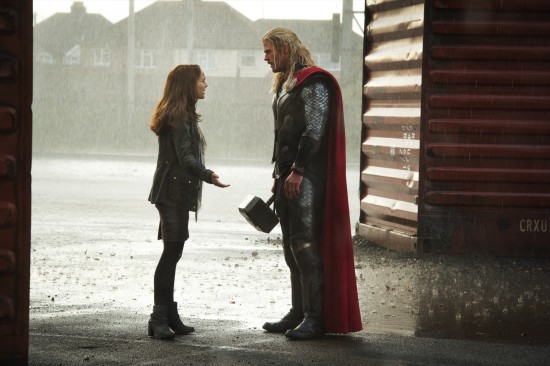 The Story:Joss Whedon read a draft of the script gave Marvel his approval. There was some hope he would come and do some polish work but that had yet to happen at the time I was on set. (Note: he later did some rewrites.)
The Story:Joss Whedon read a draft of the script gave Marvel his approval. There was some hope he would come and do some polish work but that had yet to happen at the time I was on set. (Note: he later did some rewrites.)
Thor's journey picks up from the events in the first Thor movie, moreso than from The Avengers. Thor is having to deal with taking on the responsibility of a king, and finds the secrets and the dark side of that responsibility. Tom Hiddelson says that Loki's family relationships have become "really interesting." We will get to see the opinion principle Asgard characters hold about what Loki did, and the opinion is more varied than you might think. There is no one in Asgard who thinks Loki should be the king. Tom Hiddelson jokes that it was not a good idea to throw an "apocalyptic sized tantrum". Joss Whedon encouraged Hiddleston to enjoy himself more in The Avengers, and he has brought that movie's delight in being a psychopath to Thor 2.
Jane Foster (Natalie Portman) returns and the story picks up where they left off with the rainbow bridge being fixed. Chris Hemsworth strongly hints that Jane isn't happy that he didn't call her during the NYC attack.
Chris Hemsworth says he has "meatier stuff with Tom" in this film compared to the previous movies. Thor and Loki's story will get darker and more complicated. There is more at stake is time, and its not just opposing egos. Thor and Loki have a common goal that will somehow bring them together, as the trailers have suggested. At the same time, they don't go back to being best friends. Even though Loki attempted to kill Thor on multiple occasions, they are still brothers and Thor is ambivalent towards his intentions. Hiddleston describes his on and off again relationship with Thor as "consistently ambivalent," as it is in the comics.
The film will also have some "fish out of water" moments, but much less compared to the first film.
They focused on making the combat more intimate so that "the losses are deeper and more personal."
Thor sports a more casual attire for this film. Thor's more-casual look features a dark blue suede cloak, and armor that looks more like leather, sleeveless with leather wrist bracelets and less metal.
Tom teases that there is a moment in this film where Loki wears a different costume.
We saw concept art of Odin in full warrior mode, in garb which looks more like fighting armor than royal clothing.
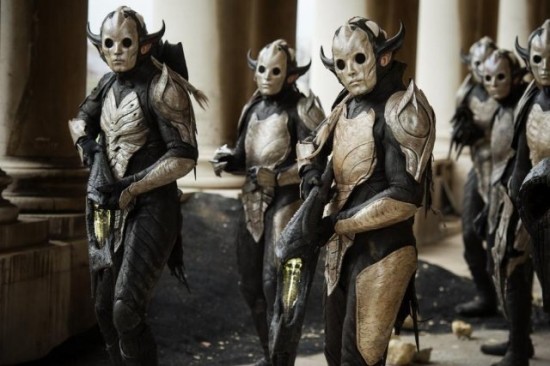 Star Wars Connections:Kevin Feige describes Thor: The Dark World as "The Empire Strikes Back of Marvel's Thor saga."
Star Wars Connections:Kevin Feige describes Thor: The Dark World as "The Empire Strikes Back of Marvel's Thor saga."
Multiple people on the production kept referring to the dark elves as like "stormtroopers."
Odin's throne room set was built on stage H at Shepperton Studios, the same stage where the ceremony scene was shot for Star Wars. (It also housed the moon set for 2001.) We were walking around the stage just a few days before Disney announced they were purchasing LucasFilm and making new Star Wars movies. Stage H is very large, the biggest at Shepperton.
We were on set on October 24th and 25th 2012, about halfway through production. First unit principal photography was scheduled From September 3 to December 23rd of that year. We visited sets at both Longcross Studios and Shepperton Studios in London, but we weren't allowed on main unit filming, as the shoot then involved a major spoiler sequence that takes place in the final act of the movie. Other movies shooting at Shepperton Studios while we were on the lot included Fast and the Furious 6 and World War Z, which was doing reshoots. Thor 2 shot on 14 states at Shepperton in addition to the builds at Longcross Studios.
The production offices on the Shepperton Studios lot were listed as "Asgard Productions II UK Ltd." and the fake title of the film being used was "The Mighty Thursday Mourning," written in a font like that of the comic book-style The Mighty Thor logo.
The film was shot with 2D Arri Alexa cameras, and will be post-converted into 3D for the theatrical release. Director Alan Taylor didn't want to make a 3D film because he was not educated in the process. Despite the post-conversion plans, he was not shooting the film with an eye for how it could look in 3D.
Taylor describes himself as a "recovering tv director". He compares directing this sequel to directing an episode of television, explaining that this is a volume two of a saga and he is trying to put his stamp on it like he does for the tv episodes he directs. His main goals were to add more weight, history, and texture than seen or felt in the first film.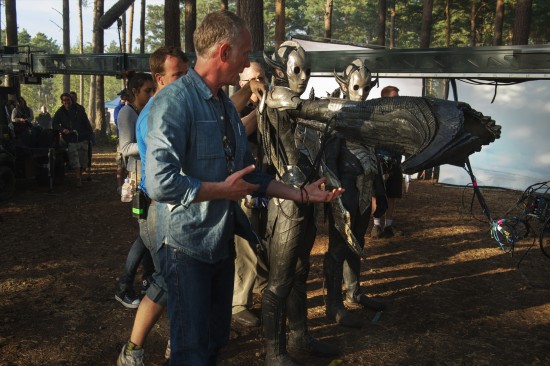 New Characters:
New Characters:
Darcy (Kat Dennings) has an intern named Ian Boothby played by Jonathan Howard (World War Z).
The story begins at a time of real strife in the nine realms. A group of invaders known as The Marauders has come to weaken the Asgardian army. Inside the Marauders' armore we'll see some weaponry that we're familiar with.
It was clear early on that the Dark Elves would be the villains. Dark Elves have white braided hair. Their costume flexes over their hair, and covers their large ears. They have whitish silver facial plates with large black eyes (or lenses). Silver chest plates fit over a black organic costume. They're very eerie.
In the world of the film, the dark elves have not been seen for 5,000 years. Their mothercraft is called "The Arc," fitted with a "black hole engine" that pulls them through space. (Rather than propelling them forward.) Their ships look like boats in the sky, with solar sails; in concept art they're very John Carter-looking. The final battle takes place in London with the dark elves and their mothership crashing down on the city. For the interiors and exteriors of the Dark Elves' ships the production shot for originality, trying to do something unique in the world of science fiction.
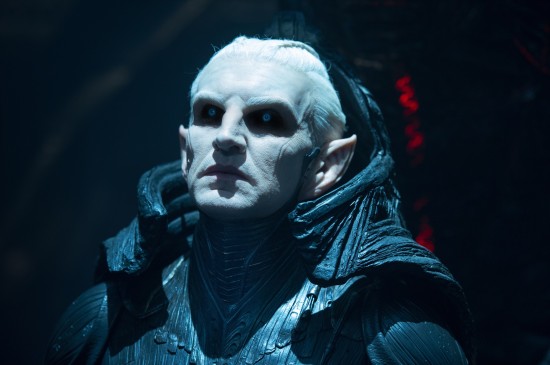 Christopher Eccleston plays Malekith the Accursed, ruler of the Dark Elves of Svartalfheim. Eccleston sports two different eye colors for the role. Malekith is on a mission of vengeance and reclaiming what's rightfully his. (As he sees it, anyway.) Prior to this story, Odin's father had to fight the Elves, which have been around since the Big Bang. Director Alan Taylor drew comparisons to Osama Bin Laden and the villain in JJ Abrams' Star Trek.
Christopher Eccleston plays Malekith the Accursed, ruler of the Dark Elves of Svartalfheim. Eccleston sports two different eye colors for the role. Malekith is on a mission of vengeance and reclaiming what's rightfully his. (As he sees it, anyway.) Prior to this story, Odin's father had to fight the Elves, which have been around since the Big Bang. Director Alan Taylor drew comparisons to Osama Bin Laden and the villain in JJ Abrams' Star Trek.
Meanwhile, the Vanir, a warrior race not quite as advanced as the Asgardians, is under attack by the Dark Elves. A ragtag band of space pirates have come together to steal as much as they can.
The ties between Malekith and Algrim, another Dark Elf, reflect the brotherly relationship of Thor and Loki. Algrim is the go-to guy to get things done.
A language and an accent were created for Adewale Akinnuoye-Agbaje's character Kurse. Akinnuoye-Agbaje spent a lot of time in the makeup chair. It took over two and a half hours to apply the make-up for Algrim and about one and a half hours to apply the make-up for Kurse. When he was hired, the actor wasn't told immediately about how many prosthetics would be required for the job. He only found out after he signed on to the film, and since all the departments work separately in secrecy, he didn't even know what the final product would look like in the end until right before the shoot. Adewale did a lot of mirror work before going in front of the camera as Kurse, trying to get use to and make the bulk of the character work best.
Kurse has three horns from either side of his head, two tusks in the front. His face looks almost like stone in texture; a charcoal black with metallic red highlights in the middle of his face. There's a fiercely loyal bond between Kurse and Malekith. You will see that there is a soul within the beast/brute of Kurse.
A stone man from Saturn faces off against Thor in the film. The character is the first person that Thor faced in the comics.
We will visit the Hall of Science, and get a glimpse into the various discoveries of the Asgardians, from what we know of the Big Bang to scientific discoveries humans have yet to make. We will learn where the Viking ships came from, and how the gods created the Vikings on earth.
The throne room is one of the few connecting locations that returns in this film, and has just a bit new detail.
Up to 11,000 weapons were used for this film. A team of up to 20 technicians worked to build new props or transform some of the props from the first film with more wear and tear.
One action scene involves 140 marauders, an assortment of weapons, some from the aliens in Avengers, a mix of roman, medieval, and nearly every earth culture. The idea is that the gang of space pirates would have taken possession of an assortment of many types of weapons from their adventures. They use axes, swords, spears, morning stars, whips, and guns.
About ten different designs for alien guns were created for the film. The guns in this movie work mostly with lasers; there was a choice to avoid cartridges or ballistic weapons.
The Dark Elf weapons include a slow gun, and a backpack that transforms into a slow gun which can also be used as a slashing weapon. The latter looks very organic, black with green undertones. Very much like something from the Alien films. The big handle portion is actually the barrel, so it looks completely backwards based on how you would expect it to be used
There are a bunch of different versions of Thor's hammer: Hard, soft, light (1.5 pounds), and hero heavy (15 kilograms).
The process of prototyping weapons in 3D was started on the movie The Golden Compass. They are still trying to figure out a way to employ the technology. For some of the background staves in the training sequence they printed out the designs with 3D printers and plated those printed designs with metal. But the results are still not where they need to be for close ups.
Thor 2: The Dark World will be in theaters on November 8.

